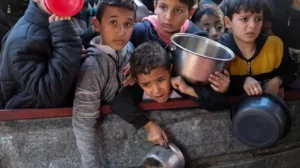Gaza faces a dire humanitarian crisis, receiving less than half the necessary aid to prevent famine after a prolonged Israeli military operation.
Hunger intensifies, and malnutrition rates are set to worsen. Despite slight improvements in aid flow, Gaza’s population, nearly all facing food insecurity, still lacks adequate sustenance.
Acute malnutrition rates among young children have surged, with significant portions affected in various regions, signaling a broader health crisis.
Reports from UNICEF and local health authorities underscore the increasing deaths from malnutrition and dehydration, especially among the youth.

Proposals to use “private contractors” for convoy protection have met resistance, further complicating the aid delivery process.
Amidst these challenges, international bodies call for Israel to allow unimpeded aid flow into Gaza to avert a larger humanitarian disaster.
The situation highlights the urgent need for a ceasefire and concerted humanitarian efforts to address the looming famine threat in Gaza.

